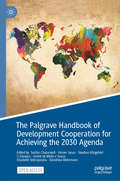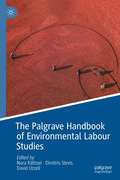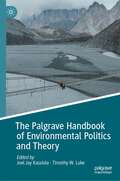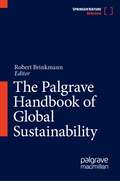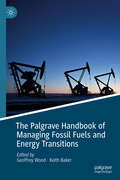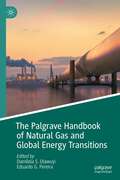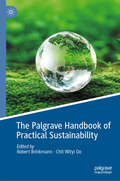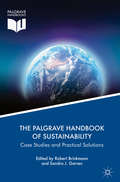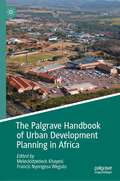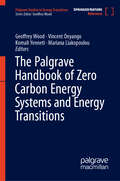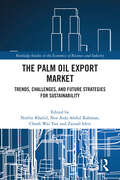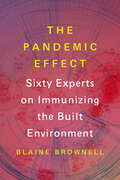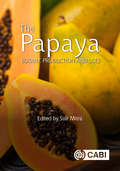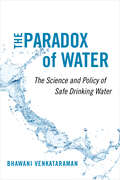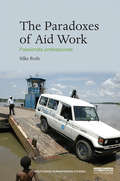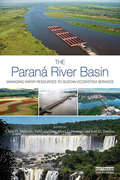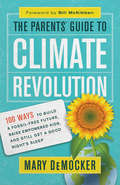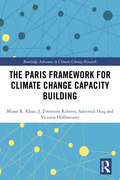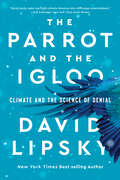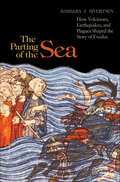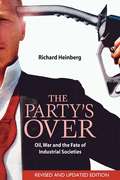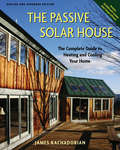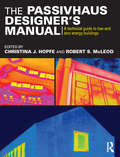- Table View
- List View
The Palgrave Handbook of Development Cooperation for Achieving the 2030 Agenda: Contested Collaboration
by Sachin Chaturvedi Stephan Klingebiel Dorothea Wehrmann Heiner Janus Xiaoyun Li André de Mello e Souza Elizabeth SidiropoulosThis open access handbook analyses the role of development cooperation in achieving the 2030 Agenda in a global context of ‘contested cooperation’. Development actors, including governments providing aid or South-South Cooperation, developing countries, and non-governmental actors (civil society, philanthropy, and businesses) constantly challenge underlying narratives and norms of development. The book explores how reconciling these differences fosters achievement of the Sustainable Development Goals.
The Palgrave Handbook of Environmental Labour Studies
by Nora Räthzel Dimitris Stevis David UzzellIn this comprehensive Handbook, scholars from across the globe explore the relationships between workers and nature in the context of the environmental crises. They provide an invaluable overview of a fast-growing research field that bridges the social and natural sciences. Chapters provide detailed perspectives of environmental labour studies, environmental struggles of workers, indigenous peoples, farmers and commoners in the Global South and North. The relations within and between organisations that hinder or promote environmental strategies are analysed, including the relations between workers and environmental organisations, NGOs, feminist and community movements.
The Palgrave Handbook of Environmental Politics and Theory (Environmental Politics and Theory)
by Timothy W. Luke Joel Jay KassiolaThis Handbook aims to provide a unique and convenient one-volume reference work, exhibiting the latest interdisciplinary explorations in this urgently burgeoning field of intellectual and practical importance. Due to its immense range and diversity, environmental politics and theory necessarily encompasses: empirical, normative, policy, political, organizational, and activist discussions unfolding across many disciplines. It is a challenge for its practitioners, let alone newcomers, to keep informed about the ongoing developments in this fast-changing area of study and to comprehend all of their implications. Through the planned volume’s extensive scope of contributions emphasizing environmental policy issues, normative prescriptions, and implementation strategies, the next generation of thinkers and activists will have very useful profiles of the theories, concepts, organizations, and movements central to environmental politics and theory. It is the editors’ aspiration that this volume will become a go-to resource on the myriad perspectives relevant to studying and improving the environment for advanced researchers as well as an introduction to new students seeking to understand the basic foundations and recommended resolutions to many of our environmental challenges. Environmental politics is more than theory alone, so the Handbook also considers theory-action connections by highlighting the past and current: thinkers, activists, social organizations, and movements that have worked to guide contemporary societies toward a more environmentally sustainable and just global order. Chapter “Eco-Anxiety and the Responses of Ecological Citizenship and Mindfulness” is available open access under a Creative Commons Attribution 4.0 International License via link.springer.com.
The Palgrave Handbook of Global Sustainability
by Robert BrinkmannThe field of sustainability continues to evolve as a discipline. The world is facing multiple sustainability challenges such as climate change, water depletion, ecosystem loss, and environmental racism. The Handbook of Sustainability will provide a comprehensive reference for the field that examines in depth the major themes within what are known as the three E’s of sustainability: environment, equity, and economics. These three themes will serve as the main organizing body of the work. In addition, the work will include sections on history and sustainability, major figures in the development of sustainability as a discipline, and important organizations that contributed or that continue to contribute to sustainability as a field. The work is explicitly global in scope as it considers the very different issues associated with sustainability in the global north and south
The Palgrave Handbook of Managing Fossil Fuels and Energy Transitions
by Keith Baker Geoffrey WoodThis Handbook is the first volume to comprehensively analyse and problem-solve how to manage the decline of fossil fuels as the world tackles climate change and shifts towards a low-carbon energy transition. The overall findings are straight-forward and unsurprising: although fossil fuels have powered the industrialisation of many nations and improved the lives of hundreds of millions of people, another century dominated by fossil fuels would be disastrous. Fossil fuels and associated greenhouse gas emissions must be reduced to a level that avoids rising temperatures and rising risks in support of a just and sustainable energy transition. Divided into four sections and 25 contributions from global leading experts, the chapters span a wide range of energy technologies and sources including fossil fuels, carbon mitigation options, renewables, low carbon energy, energy storage, electric vehicles and energy sectors (electricity, heat and transport). They cover varied legal jurisdictions and multiple governance approaches encompassing multi- and inter-disciplinary technological, environmental, social, economic, political, legal and policy perspectives with timely case studies from Africa, Asia, Australia, Europe, North America, South America and the Pacific. Providing an insightful contribution to the literature and a much-needed synthesis of the field as a whole, this book will have great appeal to decision makers, practitioners, students and scholars in the field of energy transition studies seeking a comprehensive understanding of the opportunities and challenges in managing the decline of fossil fuels.
The Palgrave Handbook of Natural Gas and Global Energy Transitions
by Damilola S. Olawuyi Eduardo G. PereiraThe Palgrave Handbook of Natural Gas and Global Energy Transitions provides an in-depth and authoritative examination of the transformative implications of the ongoing global energy transitions for natural gas markets across the world.With case studies from Africa, Asia, Europe, North America, Latin America, South America, Australia, and the Middle East, the volume introduces readers to the latest legal, policy, technological, and fiscal innovations in natural gas markets in response to ongoing global energy transitions. It outlines the risk mitigation strategies and contractual techniques — focusing on resilience planning, low-carbon business models, green procurement, climate-smart infrastructure development, accountability, gender justice, and other sustainability safeguards — that are required to maximize the full value of natural gas as a catalyst for a just and equitable energy transition and for energy security across the world.Written in an accessible style, this book outlines the guiding principles for a responsible and low-carbon approach to the design, financing, and implementation of natural gas development and commercialization. It is an indispensable text and reference work for students, scholars, practitioners, and stakeholders in natural gas, energy, infrastructure, and environmental investments and projects.
The Palgrave Handbook of Practical Sustainability
by Robert Brinkmann Chit Wityi OoThis book provides a comprehensive look at practical sustainability around the world. The book takes a distinctly regional, case study perspective and highlights different approaches to managing sustainability challenges. Chapters by authors from all corners of the world look at a range of sustainability issues including environmental sustainability, environmental equity and justice, and government and business approaches to sustainability. The authorship of the book is distinctly global which provides an important perspective to this volume. Each chapter focuses on a different sustainability problem and how it was addressed in the region. Readers will take away a tremendous amount of information as to how sustainability challenges are addressed by leaders throughout the globe.
The Palgrave Handbook of Social Sustainability in Business Education
by Soo Min Toh Aušrinė Šilenskytė Miguel Cordova Marina A. SchmitzThis book provides a holistic conceptualization of social sustainability, going beyond the topics of diversity, equity, and inclusion, and showcases how the United Nations’ Sustainable Development Goals (SDGs) emphasizing social sustainability can be integrated into business studies’ curricula in different parts of the world. A unique collection of literature comprising educational principles, content, activities, and cases will guide educators, managers of business study programs, and higher education leaders in developing engaging, high-impact educational experiences that enable students to solve grand societal challenges and grow as ethical, inclusive leaders. This handbook features a wide-range of tested teaching innovations. These cover education models addressing newest trends, such as utilizing artificial intelligence and blockchain technologies in education about-and-for socially sustainable business or skill development for enabling circular economy and sustainable production and consumption patterns. The classical, impactful yet underutilized in business studies instructional techniques such as storytelling and theatre are also discussed comprehensively. The cross-disciplinary approach of the handbook speaks to scholars aiming to research and implement business education, which connects social, environmental, and economic dimensions in quality education that promotes sustainable development.
The Palgrave Handbook of Sustainability: Case Studies And Practical Solutions
by Robert Brinkmann Sandra J. GarrenThis book provides a comprehensive overview of the practice of sustainability through a diverse range of case studies spanning across varied fields and areas of expertise. It provides a clear indication as to the contemporary state of sustainability in a time faced by issues such as global climate change, challenges of environmental justice, economic globalization and environmental contamination. The Palgrave Handbook of Sustainability explores three broad themes: Environmental Sustainability, Social Sustainability and Economic Sustainability. The authors critically explore these themes and provide insight into their linkages with one another to demonstrate the substantial efforts currently underway to address the sustainability of our planet. This handbook is an important contribution to the best practises on sustainability, drawn from many different examples across the fields of engineering, geology, anthropology, sociology, biology, chemistry and religion.
The Palgrave Handbook of Urban Development Planning in Africa
by Meleckidzedeck Khayesi Francis Nyongesa WeguloWhere can one get a synthesis of research findings on urban development planning in Africa? This book addresses this gap in knowledge by distilling existing research to provide insights into theories, research designs, empirical findings and approaches on urban development planning in Africa. Starting with the overall planning culture and strategies, the book chapters move on to specific themes such as governance, population, poverty, water, recreation, transport, agriculture, air quality and rural-urban linkages. This book reduces the prevailing risk of unnecessary duplication of research and the inadequate attention that is being given to extending research in new areas. This situation has partly been due to existing research remaining scattered in different organizations and publications and has not been subjected to critical synthesis to unearth any new developments that it contains. The book makes available research findings to be utilized in current and future urban development planning in Africa.
The Palgrave Handbook of Zero Carbon Energy Systems and Energy Transitions (Palgrave Studies in Energy Transitions)
by Geoffrey Wood Vincent Onyango Komali Yenneti Mariana LiakopoulouThe Palgrave Handbook of Zero-Carbon Energy Systems and Energy Transitions provides a comprehensive and authoritative source of information, analysis and recommendations on the multi- and inter-disciplinary subject of zero carbon energy systems. The Handbook will advance thinking and research underlying the on-going energy transition by; covering a wide range of energy technologies and sources (e.g. fossil fuels, renewables, low carbon energy) including investigating the potential of new and alternative technologies and fuel sources and looking at the power, heating/cooling and transport sectors; Looking at varied legal jurisdictions and governance approaches including developing and developed countries and investigating potential new approaches to achieving a zero carbon energy system; Providing a broad range of theoretical and methodological approaches from a range of disciplines; Inclusion of a global range of case studies from Africa, Arctic, Asia, Australasia, Europe, the Middle East, the Americas (Central, North and South) and the Pacific, from the international, national, sub-national to city/community level.
The Palm Oil Export Market: Trends, Challenges, and Future Strategies for Sustainability (Routledge Studies in the Economics of Business and Industry)
by Rahman, Nor Aida Abdul Norlin Khalid Cheah Wai Yan Zainab IdrisThis book provides a comprehensive examination of the palm oil export market, including analysis of its current challenges and move towards sustainability.Adopting a multidisciplinary approach, this volume is written by contributors ranging from the fields of economics, engineering, and chemical sciences. Chapters address a wide range of topics including trade market, environmental sustainability, economic dynamics, and future directions to implement nanotechnology and biowaste recycling in the palm oil industry. They synthesize existing research on the palm oil market, and examine the industry’s transformation efforts via technology adoption, biofuel energy research, and its response to new rules and policies from the EU market.This book would appeal greatly to scholars and researchers on international trade, supply chain management, and economic development, especially those in oil palm production and import countries.
The Pandemic Effect: Ninety Experts on Immunizing the Built Environment
by Blaine BrownellIn The Pandemic Effect, 90 leading architects, designers, materials scientists, and health officials reflect on the influence of COVID-19 on buildings and cities—and propose solutions to safeguard the built environment from future pandemics, viruses, and contagious diseases on every scale, from surfaces to society. Safety and sustainability in buildings and cities have taken on new meaning during the COVID -19 pandemic. Buildings became magnifiers of contagion instead of shelters for protection. In this essential resource for both practitioners and students of architecture, interior design, and urban design, 90 of the world's leading experts investigate a variety of approaches to future-proof architecture and buildings against widespread disease. These inoculation strategies are organized into five chapters: "Histories" offers an overview of past pandemics and prior architectural approaches; "Inside / Outside" addresses the roles of building envelopes and mechanical systems in improving indoor environmental quality; "Interventions" consists of contemporary methods for direct prevention and control; "New Strategies" consists of various architectural analyses and proposals for design changes; and "The Public Realm" considers the urban landscape and related social questions. This broad collection of perspectives explores the transformations underway in the built environment—and offers design strategies to limit the severity of subsequent pandemics.
The Papaya: Botany, Production and Uses (Botany, Production and Uses)
by Amalendu Ghosh Robert E Paull Víctor Galán Saúco Edward Evans Rebecca Ford S H Ahmad Christian Alcocer Fredy H Ballen Luis Barboza-Barquero Paul R Campbell A Chan Fure-Chyi Chen Nancy Jung Chen Ting-Chi Cheng Shih Wen Chin Rod Drew Franscisco Espadas Humberto Estrella João Paulo Fabi Gabriela Fuentes Amaranta Giron Julián Cuevas González Eric Guevara Marco V Gutiérrez-Soto Eudaldo Pérez Hernández Jian-Zhi Huang Víctor M Jiménez Chutchamas Kanchana-Udomkan Matiyar Rahaman Khan Chen-Yu Lee Wen-Li Lee Pauziah Muda M Munirah Usana Nantawan Eder Dutra Resende Jorge Manuel Santamaria-Fernandez S K Sharma N I Shukor N E Tajidin Carlos Talavera Lynton L Vawdrey Ziwei ZhouPapaya (Carica papaya) is an important and widely-cultivated tropical fruit, grown in more than 60 countries of the world. Global papaya production has grown significantly over the last few years, mainly as a result of increased production in India. Papaya has become an important agricultural export for developing countries where export revenues of the fruit provide a livelihood for thousands of people, especially in Asia and Latin America. This book includes coverage of recent research developments with the potential to improve crop yields and quality. New research has contributed to our understanding of the crop environment, plant growth and physiology of tree and fruit development with implications for both breeding and cultivation. It looks at how analysis of the papaya genome promises new, faster breeding techniques to improved cultivars and how these and other advances are helping to tackle disease like papaya ring spot viruses and major pests which cause significant losses. Key features include: updated information for sustainable papaya cultivation research developments in tackling the major production and post-harvest problems interdisciplinary and collaborative research With contributions from international experts, the book presents the current state of knowledge concerning the history, physiology, culture and marketing of papaya throughout the world. It is an essential resource for researchers, growers and all those involved in the papaya industry.
The Paradox of Water: The Science and Policy of Safe Drinking Water
by Bhawani VenkataramanWater is a molecular marvel. Its seemingly simple formula—H2O—dictates the properties that make water both essential for life and easily contaminated. Herein lies the paradox of water: we cannot live without it, but it is easily rendered "unsafe." The Paradox of Water explores the intersection of the scientific, social, and policy implications around access to safe drinking water. Drinking water is the smallest fraction of water used by a nation. Yet, the quality of this fraction is what dictates whether a community is healthy, educated, and economically sustained. Bhawani Venkataraman argues that a deeper understanding of the chemical nature of water is crucial to appreciating the challenges around access to safe drinking water. Drawing on recent research and case studies from the US and abroad, this book offers students an understanding of: the processes and oversight needed to ensure the safety of drinking water the role of the precautionary principle in managing drinking water potential solutions for expanding sustainable and equitable access to safe drinking water
The Paradoxes of Aid Work: Passionate Professionals (Routledge Humanitarian Studies)
by Silke RothThis book explores what attracts people to aidwork and to what extent the promises of aidwork are fulfilled. 'Aidland' is a highly complex and heterogeneous context which includes many different occupations, forms of employment and organizations. Analysing the processes that lead to the involvement in development cooperation, emergency relief and human rights work and tracing the pathways into and through Aidland, the book addresses working and living conditions in Aidland, gender relations and inequality among aid personnel and what impact aidwork has on the life-courses of aidworkers. In order to capture the trajectories that lead to Aidland a biographical perspective is employed which reveals that boundary crossing between development cooperation, emergency relief and human rights is not unusual and that considering these fields as separate spheres might overlook important connections. Rich reflexive data is used to theorize about the often contradictory experiences of people working in aid whose careers are shaped by geo-politics, changing priorities of donors and a changing composition of the aid sector. Exploring the life worlds of people working in aid, this book contributes to the emerging sociology and anthropology of aidwork and will be of interest to professionals and researchers in humanitarian and development studies, sociology, anthropology, political science and international relations, international social work and social psychology.
The Paraná River Basin: Managing Water Resources to Sustain Ecosystem Services (Earthscan Series on Major River Basins of the World)
by Chris D. MetcalfeThis book provides insight into the hydrology, ecosystem services and management of water resources in the Paraná River basin, including the importance of water to the socio-economic development of the countries within the watershed. Running through Brazil. Paraguay and Argentina, the Paraná River and its watershed is home to some of South America's major population centers as well as important ecosystems threatened by development. At the same time, the river is a major resource driving the economies of the nations within its boundaries. This volume examines the impacts of environmental degradation, and the tradeoffs between the energy sector and the maintenance of ecosystem services. In particular, it focuses on the threats from development to sensitive ecosystems within the basin and the challenges of transboundary management of water resources. In addition to presenting wider perspectives on water management, the volume specifically covers water infrastructure, aquatic ecosystems, water quality, geomorphological influences and the impact of climate change. Finally, by assessing each country's current status in meeting the Sustainable Development Goals this volume provides a timely analysis as national governments within the basin are becoming increasingly concerned about the sustainability of the freshwater ecosystems within the Paraná River basin. This book will be of great interest to students and scholars of water and natural resource management, environmental policy, sustainable development and Latin American studies. It will also be relevant to water management professionals.
The Parents’ Guide to Climate Revolution: 100 Ways to Build a Fossil-Free Future, Raise Empowered Kids, and Still Get a Good Night’s Sleep
by Bill McKibben Mary DeMocker“Relax,” writes author Mary DeMocker, “this isn’t another light bulb list. It’s not another overwhelming pile of parental ‘to dos’ designed to shrink your family’s carbon footprint through eco-superheroism.” Instead, DeMocker lays out a lively, empowering, and doable blueprint for engaging families in the urgent endeavor of climate revolution. In this book’s brief, action-packed chapters, you’ll learn hundreds of wide-ranging ideas for being part of the revolution — from embracing simplicity parenting, to freeing yourself from dead-end science debates, to teaching kids about the power of creative protest, to changing your lifestyle in ways that deepen family bonds, improve moods, and reduce your impact on the Earth. Engaging and creative, this vital resource is for everyone who wants to act effectively — and empower children to do the same.
The Paris Agreement
by Judith BlauThis book discusses the immediate and severe threat posed by global climate change and the various obstacles that stand in the way of action. Judith Blau presents scientific evidence relevant to The Paris Agreement (COP-21): an international treaty that promises to strengthen the global response to climate change. As she reckons with the dangers of catastrophic planetary heating, Blau discusses the clash between the deeply ingrained American tradition of individualism and the collective action and acknowledgement of intertwined fate needed to address climate change. She acknowledges that America's capitalist bent stands in contrast to the idea of the "commons"--a concept that we need to embrace if climate change is to be mitigated. The volume also explains the foundations of international human rights standards as they relate to climate change. Drawing from guiding principles of human rights and equality, the book concludes hopefully--suggesting that the people of the world can meet the challenge posed by climate change by at once acknowledging shared humanity and celebrating difference.
The Paris Framework for Climate Change Capacity Building (Routledge Advances in Climate Change Research)
by J. Timmons Roberts Saleemul Huq Mizan R Khan Victoria HoffmeisterThe Paris Framework for Climate Change Capacity Building pioneers a new era of climate change governance, performing the foundational job of clarifying what is meant by the often ad-hoc, one-off, uncoordinated, ineffective and unsustainable practices of the past decade described as 'capacity building' to address climate change. As an alternative, this book presents a framework on how to build effective and sustainable capacity systems to meaningfully tackle this long-term problem. Such a reframing of capacity building itself requires means of implementation. The authors combine their decades-long experiences in climate negotiations, developing climate solutions, climate activism and peer-reviewed research to chart a realistic roadmap for the implementation of this alternative framework for capacity building. As a result, this book convincingly makes the case that universities, as the highest and sustainable seats of learning and research in the developing countries, should be the central hub of capacity building there. This will be a valuable resource for students, researchers and policy-makers in the areas of climate change and environmental studies.
The Parrot and the Igloo: Climate And The Science Of Denial
by David LipskyA New York Times Editors’ Choice Named a Best Book of the Year in The New Yorker, Publishers Weekly, Chicago Tribune, and EcoLit Books A USA Today Must-Read Summer Book "David Lipsky spins top-flight climate literature into cliffhanger entertainment." —Zoë Schlanger, New York Times Book Review The New York Times best-selling author explores how “anti-science” became so virulent in American life—through a history of climate denial and its consequences. In 1956, the New York Times prophesied that once global warming really kicked in, we could see parrots in the Antarctic. In 2010, when science deniers had control of the climate story, Senator James Inhofe and his family built an igloo on the Washington Mall and plunked a sign on top: AL GORE'S NEW HOME: HONK IF YOU LOVE CLIMATE CHANGE. In The Parrot and the Igloo, best-selling author David Lipsky tells the astonishing story of how we moved from one extreme (the correct one) to the other. With narrative sweep and a superb eye for character, Lipsky unfolds the dramatic narrative of the long, strange march of climate science. The story begins with a tale of three inventors—Thomas Edison, George Westinghouse, and Nikola Tesla—who made our technological world, not knowing what they had set into motion. Then there are the scientists who sounded the alarm once they identified carbon dioxide as the culprit of our warming planet. And we meet the hucksters, zealots, and crackpots who lied about that science and misled the public in ever more outrageous ways. Lipsky masterfully traces the evolution of climate denial, exposing how it grew out of early efforts to build a network of untruth about products like aspirin and cigarettes. Featuring an indelible cast of heroes and villains, mavericks and swindlers, The Parrot and the Igloo delivers a real-life tragicomedy—one that captures the extraordinary dance of science, money, and the American character.
The Parting of the Sea: How Volcanoes, Earthquakes, and Plagues Shaped the Story of Exodus
by Barbara J. SivertsenFor more than four decades, biblical experts have tried to place the story of Exodus into historical context--without success. What could explain the Nile turning to blood, insects swarming the land, and the sky falling to darkness? Integrating biblical accounts with substantive archaeological evidence, The Parting of the Sea looks at how natural phenomena shaped the stories of Exodus, the Sojourn in the Wilderness, and the Israelite conquest of Canaan. Barbara Sivertsen demonstrates that the Exodus was in fact two separate exoduses both triggered by volcanic eruptions--and provides scientific explanations for the ten plagues and the parting of the Red Sea. Over time, Israelite oral tradition combined these events into the Exodus narrative known today. Skillfully unifying textual and archaeological records with details of ancient geological events, Sivertsen shows how the first exodus followed a 1628 B.C.E Minoan eruption that produced all but one of the first nine plagues. The second exodus followed an eruption of a volcano off the Aegean island of Yali almost two centuries later, creating the tenth plague of darkness and a series of tsunamis that "parted the sea" and drowned the pursuing Egyptian army. Sivertsen's brilliant account explains inconsistencies in the biblical story, fits chronologically with the conquest of Jericho, and confirms that the Israelites were in Canaan before the end of the sixteenth century B.C.E. In examining oral traditions and how these practices absorb and process geological details through storytelling, The Parting of the Sea reveals how powerful historical narratives are transformed into myth.
The Party's Over
by Richard HeinbergThe world is about to run out of cheap oil and change dramatically. Within the next few years, global production will peak. Thereafter, even if industrial societies begin to switch to alternative energy sources, they will have less net energy each year to do all the work essential to the survival of complex societies. We are entering a new era, as different from the industrial era as the latter was from medieval times. In The Party's Over, Richard Heinberg places this momentous transition in historical context, showing how industrialism arose from the harnessing of fossil fuels, how competition to control access to oil shaped the geopolitics of the twentieth century and how contention for dwindling energy resources in the twenty-first century will lead to resource wars in the Middle East, Central Asia and South America. He describes the likely impacts of oil depletion and all of the energy alternatives. Predicting chaos unless the United States--the world's foremost oil consumer--is willing to join with other countries to implement a global program of resource conservation and sharing, he also recommends a "managed collapse" that might make way for a slower-paced, low-energy, sustainable society in the future. More readable than other accounts of this issue, with fuller discussion of the context, social implications and recommendations for personal, community, national and global action, Heinberg's updated book is a riveting wake-up call for human-kind as the oil era winds down, and a critical tool for understanding and influencing current US foreign policy.
The Passive Solar House
by James KachadorianRevised and Expanded Edition-Includes CD-ROM with Custom Design SoftwareFor the past ten years The Passive Solar House has offered proven techniques for building homes that heat and cool themselves, using readily available materials and methods familiar to all building contractors and many do-it-yourself homeowners. True to this innovative, straightforward approach, the new edition of this best-selling guide includes CSOL passive solar design software, making it easier than ever to heat your home with the power of the sun. Since The Passive Solar House was first published, passive solar construction expert James Kachadorian has perfected user-friendly, Windows-compatible software to supplement the design process explained in the book by allowing homeowners/designers to enter the specifications of their design and see how changing a variable will affect its energy efficiency. This is the building book for a world of climbing energy costs. Applicable to diverse regions, climates, budgets, and styles of architecture, Kachadorian's techniques translate the essentials of timeless solar design into practical wisdom for today's solar builders. Profiles of successful passive solar design, construction, and retrofit projects from readers of the first edition provide inspiration to first-time homebuilders and renovators alike.
The Passivhaus Designer’s Manual: A technical guide to low and zero energy buildings
by Christina J. Hopfe Robert S. McLeodPassivhaus is the fastest growing energy performance standard in the world, with almost 50,000 buildings realised to date. Applicable to both domestic and non-domestic building types, the strength of Passivhaus lies in the simplicity of the concept. As European and global energy directives move ever closer towards Zero (fossil) Energy standards, Passivhaus provides a robust ‘fabric first’ approach from which to make the next step. The Passivhaus Designers Manual is the most comprehensive technical guide available to those wishing to design and build Passivhaus and Zero Energy Buildings. As a technical reference for architects, engineers and construction professionals The Passivhaus Designers Manual provides: State of the art guidance for anyone designing or working on a Passivhaus project; In depth information on building services, including high performance ventilation systems and ultra-low energy heating and cooling systems; Holistic design guidance encompassing: daylight design, ecological materials, thermal comfort, indoor air quality and economics; Practical advice on procurement methods, project management and quality assurance; Renewable energy systems suitable for Passivhaus and Zero Energy Buildings; Practical case studies from the UK, USA, and Germany amongst others; Detailed worked examples to show you how it’s done and what to look out for; Expert advice from 20 world renowned Passivhaus designers, architects, building physicists and engineers. Lavishly illustrated with nearly 200 full colour illustrations, and presented by two highly experienced specialists, this is your one-stop shop for comprehensive practical information on Passivhaus and Zero Energy buildings.
